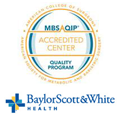 Stomach acid that backs up into the esophagus can cause
Stomach acid that backs up into the esophagus can cause
heartburn and the taste of sour liquid or regurgitated food at the back of the mouth. This condition is known as acid reflux, more specifically, gastroesophageal reflux. Acid reflux is a common condition, affecting more than
60 million Americans.
A severe or chronic case of acid reflux is called gastroesophageal reflux disease, or GERD. Reflux that occurs at least twice a week, interferes with daily life, and/or causes damage to the esophagus is defined as GERD.
Causes of Acid Reflux or GERD
When the lower esophageal sphincter muscle is very weak or malfunctions and relaxes inappropriately, acid from the stomach can backflow into the esophagus causing heartburn and other symptoms. Reflux or GERD may also be
caused by a hiatal hernia, a common abdominal abnormality in which the upper part of the abdomen pushes up through the diaphragm, causing acid to reflux into the esophagus.
Other causes of acid reflux or GERD include:
- Hiatal Hernia. A common cause of reflux is an abdomen abnormality called a hiatal hernia, in which the upper part of the abdomen pushes up through the diaphragm. The
diaphragm is a muscle separating the abdomen from the chest. When it is working correctly, it helps contain acid in the stomach, but when a hiatal hernia is present, it is easier for acid to reflux into the esophagus. - Obesity. Excess weight of the abdominal wall can cause an increase in intra-abdominal pressure, contributing to reflux or GERD.
- Pregnancy. Hormones during pregnancy can cause muscles in the abdomen to relax, allowing the backflow of stomach acid into the esophagus. A growing baby within the abdominal cavity can also contribute to
reflux. Acid reflux that is caused by pregnancy often worsens as the pregnancy progresses, and improves once the baby is delivered. - Smoking. There are a number of ways in which smoking can contribute to acid reflux, including:
- Damaging mucous membranes
- Impairing muscle reflexes in the throat
- Increasing acid secretion
- Reducing salivation, which neutralizes the effect of acid
- Reducing diaphragm muscle function
- Trigger foods. Consuming certain foods or beverages can trigger acid reflux. Common trigger foods include: alcohol, carbonated beverages, chocolate, citrus fruits, fatty or fried foods, tomato-based
foods, garlic and onions, and spicy foods.
Acid Reflux Symptoms
Symptoms of acid reflux most often occur after eating a large or heavy meal, or bending over or lying down soon after eating. Oftentimes, symptoms of acid reflux or GERD are more noticeable at night. While symptoms can vary,
common symptoms of reflux and GERD include:
- Heartburn. Also called acid indigestion, heartburn is a burning pain in the chest.
- Regurgitation. When acid backs up into the throat, it is called regurgitation. This can cause a sour or bitter taste in the mouth, or even a “wet burp.”
- Dyspepsia. Stomach discomfort known as dyspepsia is a general term that may refer to burping, nausea after eating, stomach bloating or fullness, or upper abdominal pain and discomfort.
Though acid reflux is very common and rarely serious, symptoms can be painful and damaging and should not be ignored. Damage and scarring in the esophagus can cause a narrowing of the esophageal passageway, which can make it
difficult to swallow—a condition known as a stricture. If left untreated, ongoing damage from acid reflux can cause a condition called Barrett’s esophagus, which can lead to esophageal cancer.
Tests and Diagnosis
Three in 10 people will experience heartburn at least once a month. Although heartburn itself isn’t dangerous, chronic irritation of the esophagus caused by acid reflux or GERD can lead to more serious complications as
previously mentioned. Acid reflux disease may be diagnosed using any one or a combination of tests such as the:
- Barium Swallow Radiograph, or upper GI
- Endoscopy, or EGD
- Biopsy
- Esophageal Manometry
- pH Monitoring
Acid Reflux Treatment and Surgery
Over-the-counter medication and lifestyle changes including weight loss, eating smaller meals, and avoiding trigger foods can help reduce or prevent cases of occasional acid reflux. Treating GERD may require prescription
medications and in some cases, minimally invasive surgery.
If lifestyle changes and over-the-counter medication fail to control symptoms, if complications from reflux occur, or if the patient wishes to avoid long-term medication use, surgery may be recommended. There are two
surgical procedures commonly used to treat acid reflux: fundoplication and transloral incisionless fundoplication (TIF). At Abdominal Surgery Specialists, we only perform fundoplication to treat reflux.
Dr. Nick Nicholson discusses GERD treatment options with Good Morning Texas.
August 31, 2016
Minimally Invasive Surgery
If GERD is caused by a hiatal hernia and these measures fail to control symptoms or complications occur, surgical repair of the hernia may be
necessary.
If the patient wishes to avoid long-term medication use to treat acid reflux, surgical procedures may be used to strengthen the lower esophageal sphincter. Fundoplication is a common procedure for GERD.
- Fundoplication. During this procedure, the very top of the stomach is wrapped around the lower esophagus in order to tighten the lower esophageal sphincter to prevent reflux. This procedure is usually
performed laparoscopically using three to five small incisions in the abdomen. A camera is inserted through one of the incisions, allowing the doctor to view the procedure on a video monitor. The remaining incisions
accommodate the surgical instruments. If the patient also has a hiatal hernia, it can be repaired during this procedure.
To learn more about the surgical treatments for acid reflux or GERD, click here.












